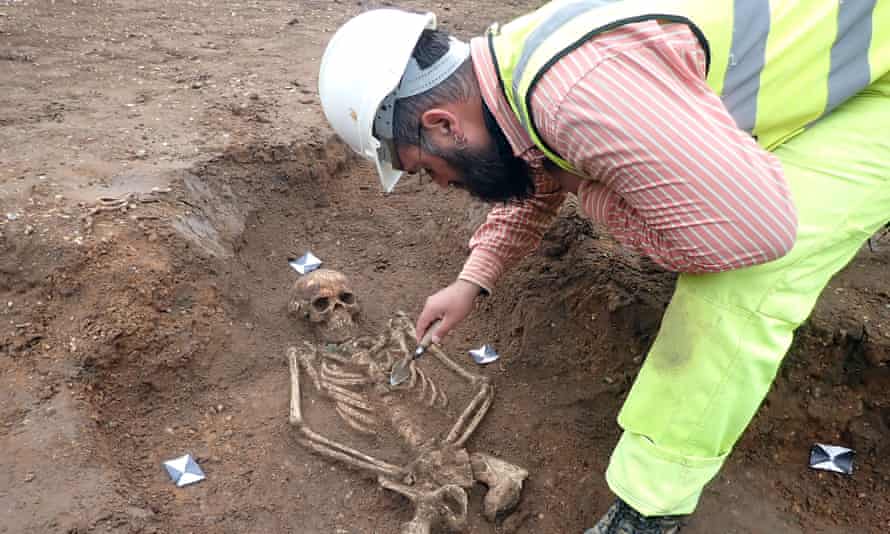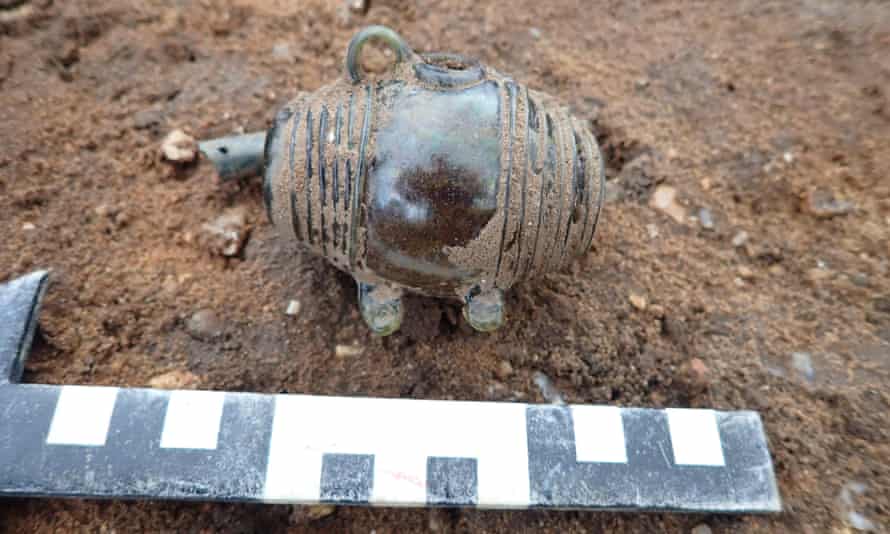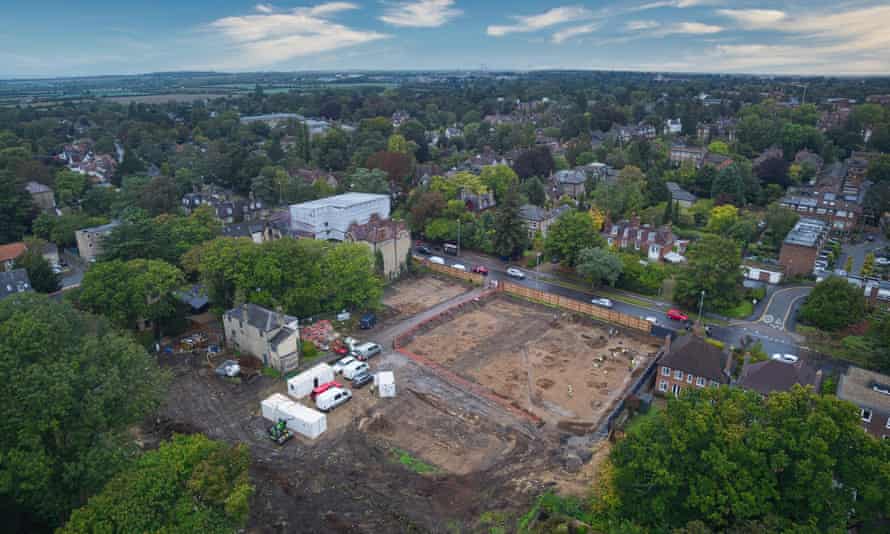Melodi
Disaster Cat
The Guardian tends to use copy-protect on their photographs (some copy and some don't) so this article may be best viewed at the link. I THINK this is the same excavation that I posted about a couple of months ago but I'm not sure, either way, they are both windows into the 6th century, just the Post-Roman period in England. I notice some of the burials show some continuation of Roman customs and others do not, which adds fuel to the theory (noted in the articles about the Roman buildings and Mosaics constructed in the "post-Roman" period, that cultures combined rather than were totally conquered and replaced by the Saxons).
Also, the "Plague of Justinian" they will be testing the bodies for is now known to be a wave of Yersinia Pestis (The Black Death) with slightly different symptoms, that may also have killed at least 1/3 of Europe in the 6th Century the same way it would later do in the 14th, but research on that is still ongoing. The DNA information is fairly new and sites are older sites from Turkey to Scandinavia are still being tested for this.
- Melodi

 www.theguardian.com
'Find of the century': medieval hoard of treasures unearthed in Cambridge
www.theguardian.com
'Find of the century': medieval hoard of treasures unearthed in Cambridge
Graves found under demolished student halls are providing valuable insight into life in a post-Roman settlement

The human remains found at the Cambridge site are remarkably well preserved in the alkaline soil. Photograph: Albion Archaeology
Donna Ferguson
Sat 30 Jan 2021 15.40 GMT
428
An early medieval graveyard unearthed beneath student accommodation at Cambridge University has been described as “one of the most exciting finds of Anglo-Saxon archaeology since the 19th century”.
King’s College discovered the “extensive” cemetery, containing more than 60 graves, after demolishing a group of 1930s buildings which had recently housed graduates and staff in the west of the city, to make way for more modern halls.

Friar crushed by cart: bone analysis hints at causes of medieval deaths
Read more
Around 200 items in the graves, including bronze brooches, bead necklaces, swords, short blades, pottery and glass flasks, have been systematically uncovered. Most date from the early Anglo-Saxon period (c400-650 CE), although evidence of iron age structures and Roman earthworks has also been found.
Dr Caroline Goodson, who teaches early medieval history at King’s, said the human remains they found were remarkably “well preserved”. “The alkaline soil, which is typical around here, hasn’t decomposed the bones.”
This is significant, because it will enable archaeologists to apply very modern scientific techniques to reveal the diet and DNA of the dead, permitting analysis of migration and family relationships.
Goodson said excavators had been “surprised” to find so many graves and such an extensive early medieval cemetery surrounded by Roman ditches and so close to the remains of Roman Cambridge. According to Bede’s Ecclesiastical History, which was written in the eighth century, Cambridge was abandoned – like many other Roman towns – when the Romans withdrew their military forces from England during the 5th century. “We already know that Cambridge wasn’t fully abandoned. But what we’re seeing now is a greater and clearer picture of life in the post-Roman settlements.”

A late Roman glass flask found at the site. Photograph: Albion Archaeology
Goodson speculates that people living in Cambridgeshire were a mix of descendants from earlier Roman populations and recent migrants to Britain from the continent, living in a post-imperial world. “They are no longer living as the Romans did, they’re eating differently, dressing differently and finding different ways of exploiting the land. They are changing the way they are living during a period of considerable fluidity.”
Some of the finds throw up questions about the emotional connections people living at the time of the burials may have felt towards the Romans who lived in Cambridge before them. In one grave, archaeologists found a body buried with what appears to be a late Roman piece of glass shaped like a small barrel for storing wine. “It looks like a classic Roman object being reused in a post-Roman context, as grave goods.” Another grave looks like a typical late Roman burial from the fifth century, suggesting there may have been continuity of use of the burial ground from the Roman period onwards. “That would be really interesting,” said Goodson.

The site of the dig, in the west of the city. Photograph: Dronescapes
So far archaeologists have not found “strong evidence” that people living in the sixth century were still choosing to bury their dead near late Roman graves, but few graveyards of this size have ever been scientifically excavated using modern methods and technologies, such as advanced radiocarbon dating techniques and isotopic analysis. “It would be great to say very clearly – and we’re going to need an ample suite of carbon-14 dates to do this – that we’ve got people using this site from the fifth until the seventh century,” says Goodson. “We can see that the burial of the dead and the treatment of their bodies is particularly significant to the living in a way that is different from elsewhere in the post-Roman world.” That points to a different world view and a different “cosmology”: “It’s a new form of commemoration.”
She hopes to find out whether anyone in the cemetery died of the Justinianic plague, a pandemic that raged across Europe in the 540s.
“I’m really interested to find out whether it was in Cambridge, too, and how much that relates to what else was going on.”
Also, the "Plague of Justinian" they will be testing the bodies for is now known to be a wave of Yersinia Pestis (The Black Death) with slightly different symptoms, that may also have killed at least 1/3 of Europe in the 6th Century the same way it would later do in the 14th, but research on that is still ongoing. The DNA information is fairly new and sites are older sites from Turkey to Scandinavia are still being tested for this.
- Melodi

'Find of the century': medieval hoard of treasures unearthed in Cambridge
Graves found under demolished student halls are providing valuable insight into life in a post-Roman settlement
Graves found under demolished student halls are providing valuable insight into life in a post-Roman settlement

The human remains found at the Cambridge site are remarkably well preserved in the alkaline soil. Photograph: Albion Archaeology
Donna Ferguson
Sat 30 Jan 2021 15.40 GMT
428
An early medieval graveyard unearthed beneath student accommodation at Cambridge University has been described as “one of the most exciting finds of Anglo-Saxon archaeology since the 19th century”.
King’s College discovered the “extensive” cemetery, containing more than 60 graves, after demolishing a group of 1930s buildings which had recently housed graduates and staff in the west of the city, to make way for more modern halls.

Friar crushed by cart: bone analysis hints at causes of medieval deaths
Read more
Around 200 items in the graves, including bronze brooches, bead necklaces, swords, short blades, pottery and glass flasks, have been systematically uncovered. Most date from the early Anglo-Saxon period (c400-650 CE), although evidence of iron age structures and Roman earthworks has also been found.
Dr Caroline Goodson, who teaches early medieval history at King’s, said the human remains they found were remarkably “well preserved”. “The alkaline soil, which is typical around here, hasn’t decomposed the bones.”
This is significant, because it will enable archaeologists to apply very modern scientific techniques to reveal the diet and DNA of the dead, permitting analysis of migration and family relationships.
Goodson said excavators had been “surprised” to find so many graves and such an extensive early medieval cemetery surrounded by Roman ditches and so close to the remains of Roman Cambridge. According to Bede’s Ecclesiastical History, which was written in the eighth century, Cambridge was abandoned – like many other Roman towns – when the Romans withdrew their military forces from England during the 5th century. “We already know that Cambridge wasn’t fully abandoned. But what we’re seeing now is a greater and clearer picture of life in the post-Roman settlements.”

A late Roman glass flask found at the site. Photograph: Albion Archaeology
Goodson speculates that people living in Cambridgeshire were a mix of descendants from earlier Roman populations and recent migrants to Britain from the continent, living in a post-imperial world. “They are no longer living as the Romans did, they’re eating differently, dressing differently and finding different ways of exploiting the land. They are changing the way they are living during a period of considerable fluidity.”
Some of the finds throw up questions about the emotional connections people living at the time of the burials may have felt towards the Romans who lived in Cambridge before them. In one grave, archaeologists found a body buried with what appears to be a late Roman piece of glass shaped like a small barrel for storing wine. “It looks like a classic Roman object being reused in a post-Roman context, as grave goods.” Another grave looks like a typical late Roman burial from the fifth century, suggesting there may have been continuity of use of the burial ground from the Roman period onwards. “That would be really interesting,” said Goodson.

The site of the dig, in the west of the city. Photograph: Dronescapes
So far archaeologists have not found “strong evidence” that people living in the sixth century were still choosing to bury their dead near late Roman graves, but few graveyards of this size have ever been scientifically excavated using modern methods and technologies, such as advanced radiocarbon dating techniques and isotopic analysis. “It would be great to say very clearly – and we’re going to need an ample suite of carbon-14 dates to do this – that we’ve got people using this site from the fifth until the seventh century,” says Goodson. “We can see that the burial of the dead and the treatment of their bodies is particularly significant to the living in a way that is different from elsewhere in the post-Roman world.” That points to a different world view and a different “cosmology”: “It’s a new form of commemoration.”
She hopes to find out whether anyone in the cemetery died of the Justinianic plague, a pandemic that raged across Europe in the 540s.
“I’m really interested to find out whether it was in Cambridge, too, and how much that relates to what else was going on.”


